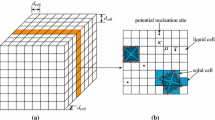Abstract
The development of additive technologies and their application in industry is associated with the possibility of predicting the final properties of a crystallized added material. This paper describes the problem characterized by a dynamic and spatially nonuniform computational complexity, which, in the case of uniform decomposition of a computational domain, leads to an unbalanced load on computational cores. The strategy of partitioning of the computational domain is used, which minimizes the CPU time losses in the serial computations of the additive technological process. The chosen strategy is optimal from the standpoint of a priori unknown dynamic computational load distribution. The scaling of the computational problem on the cluster of the Institute on Laser and Information Technologies (RAS) that uses the InfiniBand interconnect is determined. The use of the parallel code with optimal decomposition made it possible to significantly reduce the computational time (down to several hours), which is important in the context of development of the software package for support of engineering activity in the field of additive technology.
Similar content being viewed by others
References
B. Hendrickson and T. G. Kolda, “Graph Partitioning Models for Parallel Computing,” Parallel Computing 26 (12), 1519–1534 (2000).
K. V. Pavskii, M. G. Kurnosov, and A. Yu. Polyakov, “Optimization Tools of Parallel Simulation of Nanostructures with Quantum Dots,” Avtometriya 50 (3), 56–61 (2014) [Optoelectron., Instrum., Data Process. 50 (3), 260–265 (2014)].
M. Wang, Y. Tang, X. Guo, and X. Ren, “Performance Analysis of the Graph-Partitioning Algorithms Used in OpenFOAM,” in Proc. of the IEEE 5th Intern. Conf. on Advanced Computational Intelligence (ICACI), (Nanjing, China, (2012)).
OpenFOAM. http://www.openfoam.org.
R. V. Grishaev, F. Kh. Mirzade, V. G. Niziev, et al., “Simulation of Melting and Crystallization in Selective Laser Sintering with Metal Powder Injection,” Fizika i Khimiya Obrabotki Materialov, No. 1, 12–23 (2013).
F. Kh. Mirzade, V. G. Niziev, V. Ya. Panchenko, et al., Kinetic Approach in Numerical Modeling of Melting and Crystallization at Laser Cladding with Powder Injection,” Phys. B: Condensed Matter 423, 69–76 (2013).
M. D. Khomenko, V. Ya. Panchenko, and V. G. Niziev, “Study of the Microstructure of a Deposited Layer in Laser Sintering with Coaxial Powder Application,” Izv. Ros. Akad. Nauk. Ser. Fizicheskaya 80 (4), 422–427 (2016).
M. D. Khomenko, V. Y. Panchenko, V. G. Niziev, et al., “Numerical Investigation of the Microstructure of a Clad Layer Produced via Laser Cladding with Coaxial Metal Powder Injection,” Bull. Russian Acad. Sci. Physics 80 (4), 381–386 (2016).
F. Kh. Mirzade, M. D. Khomenko, and V. G. Niziev, “Numerical Simulation of Solute Evolution During Laser Cladding with Nickel Superalloy Powder Injection,” Opt. Quant. Electron. 48 (11), 513-1–513-12 (2016).
F. Rösler and D. Brüggemann, “Shell-and-Tube Type Latent Heat Thermal Energy Storage: Numerical Analysis and Comparison with Experiments,” Heat Mass Transfer 47 (8), 1027–1033 (2011).
OpenFOAM Foundation. The Open Source CFD Toolbox User Guide. 2014. http://cfd.direct/openfoam/userguide/.
H. Nilsson, “Some Experiences on the Accuracy and Parallel Performance of OpenFOAM for CFD in Water Turbines,” in Proc. of the 8th Intern. Conf. on Applied Parallel Computing: State of the Art in Scientific Computing. Ser. Lecture Notes in Comput. Sci. (Springer-Verlag, Berlin — Heidelberg, 2007), Vol. 4699, pp. 168–176.
Author information
Authors and Affiliations
Corresponding author
Additional information
Original Russian Text © M.D. Khomenko, A.V. Dubrov, F.Kh. Mirzade, 2016, published in Avtometriya, 2016, Vol. 52, No. 6, pp. 110–119.
About this article
Cite this article
Khomenko, M.D., Dubrov, A.V. & Mirzade, F.K. Decomposition strategies in the problems of simulation of additive laser technology processes. Optoelectron.Instrument.Proc. 52, 621–629 (2016). https://doi.org/10.3103/S8756699016060145
Received:
Published:
Issue Date:
DOI: https://doi.org/10.3103/S8756699016060145




